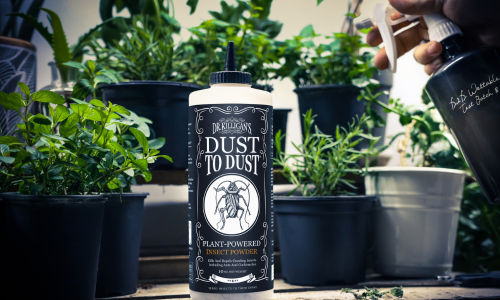Welcome to the green side of gardening, where the well-being of your plants, your family and our environment takes center stage. In a world where chemical-heavy solutions are commonplace, choosing safer, more natural alternatives ensures your gardening practices contribute positively to the ecosystem.
The essence of minimum-risk pest products
Recognized by the U.S. Environmental Protection Agency (EPA), minimum-risk products offer a beacon of safety in the vast sea of pest control options. These products stand apart for their gentle impact on human health and the environment, exempt from federal registration due to their low-risk ingredients composed of natural substances like essential oils, minerals and botanical extracts. Examples include:
- Eugenol: Found in clove oil and other essential oils, serves as a broad-spectrum insecticide, attacking pests' nervous systems, which results in rapid paralysis and death.
- Citric acid: Utilized for its antifungal properties and as an environmentally friendly insect repellent, citric acid disrupts the insect's outer shell, leading to dehydration and death.
- Rosemary: Its oil is prized for insecticidal properties, effectively targeting a wide range of pests by disrupting their nervous system.
This exemption is not just bureaucratic ease; it represents a rigorous assessment of their safety profile, ensuring these ingredients pose minimal risk to humans and pets. Embracing these solutions means you're not only choosing efficacy but also safeguarding the health of your garden and those who enjoy it, making an informed choice towards a more sustainable and health-conscious pest management practice.
The science behind safety and effectiveness
How can a product be gentle on us yet harsh on pests? The secret lies in targeting the unique biological systems of pests. Ingredients in minimum-risk products exploit specific weaknesses in pests without harming larger organisms. This precision stems from several key factors:

- Nervous system tolerance: Mammals' complex nervous systems are unaffected by the low concentrations used in these products, making them safe for humans and pets.
- Biological specificity: Certain ingredients are specifically designed to protect beneficial insects like bees, leveraging differences in biological pathways to avoid harm.
- Olfactory system differences: The scents that repel pests are formulated to not affect humans and pets, thanks to our more developed olfactory systems.
- Hydration mechanism targeting: The products focus on disrupting pests' hydration mechanisms—a tactic that does not impact larger organisms that do not rely on a similar protective coating for moisture retention.
Now, let's delve into specific examples of how these minimum-risk ingredients uniquely target pests:
- Silica (a supportive ingredient in Dust to Dust): Enhances the efficacy of active ingredients. While it does not kill pests directly, silica damages the protective waxy layer of insects such as aphids and beetles, making them more susceptible to the lethal effects of our essential oils by facilitating oil absorption and hastening dehydration.
- Peppermint oil (an essential oil): Targets the olfactory system of pests such as ants and spiders, overwhelming their senses and acting as a potent repellent.
- Neem oil (a botanical extract): Interferes with the hormone system of pests like whiteflies and mites, preventing them from feeding, growing and reproducing.
- Cedar oil (an essential oil): Utilizes its sharp scent to repel a variety of pests, including moths and fleas, by masking the scents they use to navigate and communicate.
These examples underscore the effectiveness of minimum-risk products in providing a targeted, environmentally friendly solution to pest control, ensuring safety for humans and pets.
Practical guide to using silica in your garden
Silica, as found in Dust to Dust Plant-Powered Insect Powder, serves as a stellar component for garden pest control, presenting a non-toxic method to fend off pests. To employ its capabilities responsibly, consider the following guidance:

- Targeted application: Directly apply Dust to Dust around the base of plants prone to pest invasions. Aim for precise application rather than liberal use to avoid affecting beneficial insects. Use the Insect Buster Bulb Duster for optimal product distribution.
- Reapplication insight: Ensure continuous defense by reapplying after rainfall or in high-traffic areas. Dust to Dust's visibility aids in identifying treated versus untreated zones, making it straightforward to maintain a pest-free barrier through consistent reapplication.
- Safety first: While silica is naturally derived, it's still important to consider using protective gear to prevent inhaling fine particles, particularly for individuals prone to allergies. For enhanced safety, and if opting out of a face mask, ensure the applicator is used low—below waist level or close to the ground—to minimize airborne particles.
Strategically combatting insect invasions in your garden
When confronting an active insect invasion, it's crucial to amplify your garden's defenses by meticulously applying Dust to Dust directly onto nests and the areas surrounding them, such as locations favored by ants or cockroaches. Addressing these epicenters of pest activity is a proactive step towards eliminating the immediate threat.
However, effective control involves patience and persistence; monitoring these areas and reapplying the product as needed are key components of a successful strategy.
Eradicating a pest infestation, especially when dealing with hundreds (of cockroaches) or thousands (of ants) isn't an overnight solution. Initial application may yield visible results within a day or two by eliminating those pests that encounter the treatment, but these are often just a fraction of the colony. Patience and consistent application are essential. Stream it, monitor and reapply.
Applying Dust to Dust: Methods for garden health

- Wettable application method: Create a diluted mixture by blending 1 part Dust to Dust with 8 parts water, suitable for watering plants or as a foliar spray.
- Note: It will need to be shaken frequently and a standard-sized, high-output trigger sprayer (similar to our Six Feet Under trigger sprayer), on stream setting, works well.
- Soil incorporation: Mix Dust to Dust into the soil, which will enhance plant nutrient uptake—ideal for repotting or preparing new beds. For optimal results, integrate the powder about 2 to 4 inches deep into the soil, using a ratio of approximately 1 part Dust to Dust to 10 parts soil.
- Note: Prior research into the specific nutritional needs of your plants can further tailor this application to ensure maximum benefit without disrupting the soil's balance.
- Top dressing: Apply Dust to Dust as a top layer on the soil. Over time, watering helps the silica reach plant roots, benefiting established plants without disturbance.
Balancing act: Protecting beneficial insects
The challenge with any product is preserving the garden’s helpful inhabitants. While silica and essential oils are selective in their action, application technique matters. Avoid direct application on flowers or during peak pollinator activity hours to safeguard our beneficial allies. It's this mindful approach that underscores our commitment to eco-friendly gardening.
Dust to Dust: A case study in minimum-risk pest control
Dust to Dust encapsulates the essence of minimum-risk pest control, providing gardeners with a solution that balances efficacy with environmental responsibility. Its unique formulation, blending silica and essential oils, not only effectively wards off pests but also contributes to the sustainability of gardening practices by avoiding the issue of pesticide resistance.

Charlie's endorsement of Dust to Dust shines a light on its practicality and safety: 'Dr. Killigan’s has created wonderful non-toxic and easy-to-use bug products. I purchased Dust to Dust to rescue my cucumber plants from aphids in mid-August. It was very easy to apply with the Bulb Duster just where it was needed... and it worked amazingly well on the zucchini beetles!! It was wonderful to be able to use a safe product in my garden. Thank you, Dr. Killigan’s!!'
This personal account underlines the dual advantage of Dust to Dust: it not only solves specific pest challenges efficiently but does so in a manner that prioritizes both garden health and environmental care.
For those seeking deeper insights into leveraging the benefits of silica for garden health and understanding how silica-based nutrients can bolster plant growth, we invite you to explore further resources:
- The Essential Guide to Using Silica for Your Plants
- Unlocking Growth Potential: How Silica Nutrients Benefit Your Plants
Embrace a greener tomorrow with Dr. Killigan’s
At Dr. Killigan’s, our commitment goes beyond crafting safe products; we are at the forefront of fostering continuous improvement and transparency. By selecting our eco-friendly solutions, you become part of a movement dedicated to not just safeguarding your garden but championing the health of our planet. Embracing minimum-risk products like Dust to Dust signifies more than an effective pest control strategy; it reflects a commitment to cultivating a garden that thrives in harmony with nature's delicate balance.
Join us on this journey to a healthier garden and planet. With Dr. Killigan's innovative products by your side, you're not just fighting pests—you're contributing to a world where gardens flourish as bastions of environmental responsibility. Let's cultivate a future where every garden is a testament to safety, efficacy and eco-conscious care. Here’s to embarking on a path to a thriving, pest-free home with Dr. Killigan's. Happy gardening!










